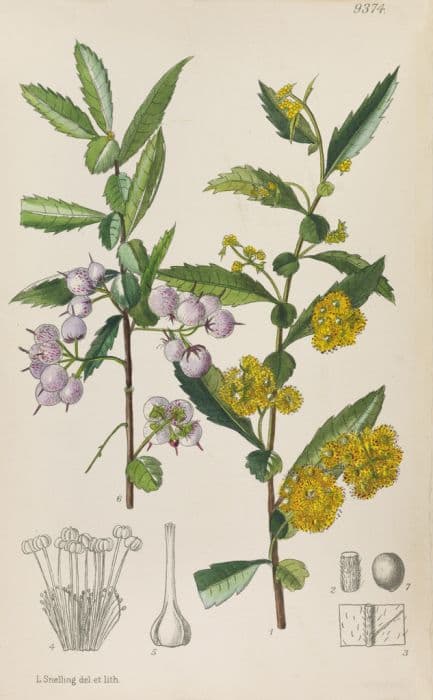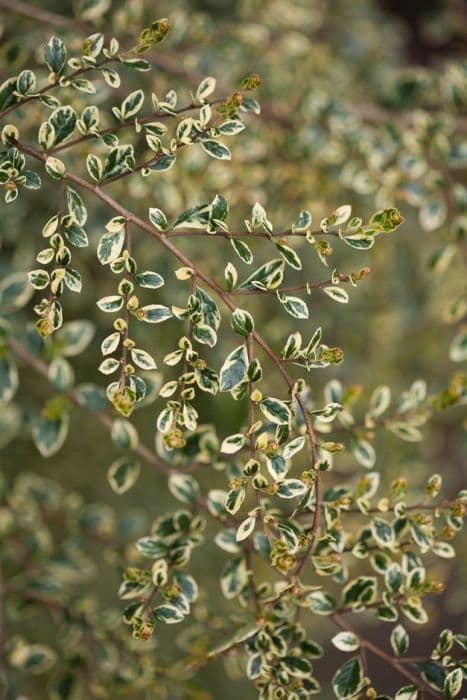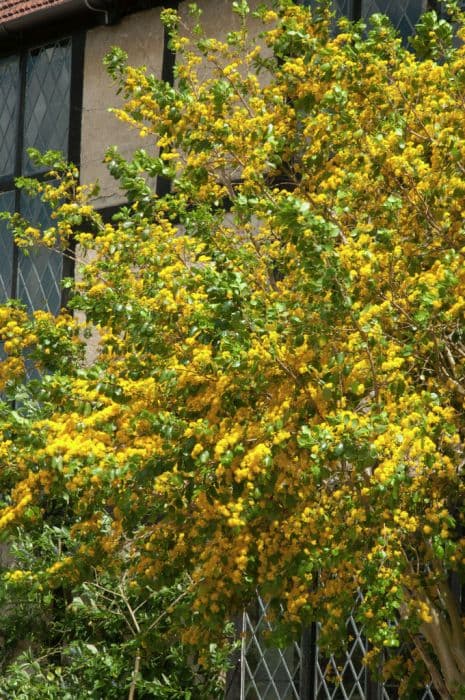Swiss Willow Salix helvetica






ABOUT
Salix helvetica, most commonly known as the Swiss willow, is characterized by its attractive appearance, which consists of a silvery-grey hue due to the fine hairs that cover its foliage and stems. Its leaves are elongated, with a slightly curved shape, sporting toothed margins that give the foliage a textured look. When the leaves first emerge in the spring, they display a softer, downy texture which later matures into a slightly tougher surface, all the while maintaining their shimmering silvery appeal. The Swiss willow also produces catkins, which are the reproductive structures typical of willows. These catkins appear before the leaves fully unfurl. On male plants, these structures are long, slender, and yellow-colored due to the presence of pollen. Conversely, the female catkins are typically greenish and grow elongated as they mature, eventually producing small seeds. The bark of the Swiss willow is another distinguishing feature, often cracking with age, it possesses a rugged texture that can add to the characteristic charm of the plant. The overall visual impact of the Swiss willow is one of delicate beauty, with an alluring color palette and form that can appeal to various landscaping or garden design themes, offering a picturesque presence in the environments it inhabits.
About this plant
 Names
NamesFamily
Salicaceae
Synonyms
Swiss Willow, Helvetica Willow
Common names
Salix helvetica
 Toxicity
ToxicityTo humans
Swiss Willow (Salix helvetica) is not commonly listed as a toxic plant to humans. Members of the Salix genus, including willows, are known for containing salicin, a chemical that was originally used to create aspirin. While not typically poisonous, excessive consumption of willow bark or leaves might cause negative effects similar to those of aspirin overdose, which can include stomach pain, nausea, vomiting, and diarrhea. In most cases, casually ingesting parts of the Swiss Willow should not be harmful to humans, but always exercise caution and avoid consuming plant material that is not commonly recognized as food.
To pets
Swiss Willow (Salix helvetica) is typically not considered toxic to pets. Similar to its effects on humans, willows contain salicin, which can cause mild to moderate gastrointestinal irritation if consumed in large quantities. Typical symptoms in pets might include vomiting or diarrhea. Generally, pets nibbling on the leaves or bark in small amounts shouldn't experience serious issues. However, large doses can be harmful, so it is always best to prevent pets from ingesting substantial quantities of plants not intended for consumption.
 Characteristics
CharacteristicsLife cycle
Perennials
Foliage type
Deciduous
Color of leaves
Green
Flower color
Yellow
Height
3-12 feet (0.91-3.66 meters)
Spread
3-12 feet (0.91-3.66 meters)
Plant type
Shrub
Hardiness zones
6
Native area
Europe
Benefits
 General Benefits
General Benefits- Landscape enhancement: Swiss Willow (Salix helvetica) adds aesthetic value to gardens and landscapes with its silvery-grey foliage and compact growth habit.
- Erosion control: Its root system helps stabilize soil on slopes and riverbanks, preventing erosion.
- Wildlife habitat: Provides shelter and nesting sites for birds, and the catkins serve as an early food source for bees and other insects.
- Adaptability: Tolerates a wide range of soil types and is resilient in different environmental conditions, making it suitable for varied landscapes.
- Drought resistance: Once established, Swiss Willow can withstand periods of drought, which is beneficial in areas with water scarcity.
- Windbreak: Can be planted in rows to serve as windbreaks, protecting against soil erosion and reducing wind speed in cultivated areas.
- Ornamental use: The plant's distinctive appearance, including its catkins and foliage texture, is prized for ornamental purposes.
 Medical Properties
Medical Properties- Anti-inflammatory: Salix helvetica contains salicin, which can be metabolized into salicylic acid, a compound with anti-inflammatory properties.
- Analgesic: Due to the salicin content, this plant may possess pain-relieving properties.
- Antipyretic: Traditionally used to reduce fever, as salicin can help lower body temperature.
- Antirheumatic: Salix helvetica has been used in folk medicine to ease rheumatic pain and inflammation.
 Air-purifying Qualities
Air-purifying QualitiesThis plant is not specifically known for air purifying qualities.
 Other Uses
Other Uses- Salix helvetica, commonly known as Swiss willow, can be used in basket weaving due to its flexible branches that are strong and easy to work with when soaked.
- The wood of the Swiss willow is suitable for carving small objects and utensils, as it is relatively soft and can be finely detailed.
- Swiss willow branches can serve as natural barriers or fencing when planted densely, utilizing their fast-growing nature to create privacy screens.
- In bonsai cultivation, Swiss willow can be trained into miniature tree forms, appreciated for its delicate leaves and interesting bark texture.
- Due to its tenacious roots, Swiss willow can be employed in soil erosion control projects, particularly along riverbanks and in areas prone to landslides.
- The catkins produced by Swiss willow provide early spring forage for bees and other pollinators looking for nectar and pollen resources.
- Landscape designers use the Swiss willow in garden settings for its unique silvery foliage and ability to add vertical interest to mixed plantings.
- In some cultures, the twigs of the Swiss willow are used in traditional rituals and as a symbol of protection or fertility.
- Swiss willow sap can be collected and used as a base for natural rooting hormones to aid in the propagation of other plant cuttings.
- The resilient bark of Swiss willow can be turned into a natural string or cordage for various craft and survival applications.
Interesting Facts
 Feng Shui
Feng ShuiThe Swiss Willow is not used in Feng Shui practice.
 Zodiac Sign Compitability
Zodiac Sign CompitabilityThe Swiss Willow is not used in astrology practice.
 Plant Symbolism
Plant Symbolism- Flexibility: The Swiss Willow, like other willows, has slender branches that are flexible and bend without breaking. This symbolizes adaptability and resilience.
- Grief and Mourning: In many cultures, willow trees are associated with sorrow due to their drooping branches. Swiss Willow may be used to represent these feelings.
- Healing: Historically, willows have been used for their medicinal properties. The Swiss Willow could symbolize healing, both physical and emotional.
- Hope: Even in challenging conditions, willows can root and grow. Swiss Willow can symbolize hope and the possibility of new beginnings.
 Water
WaterThe Swiss Willow prefers consistent moisture and should be watered deeply, especially during its growing season in spring and summer. It generally requires watering every week, but this may vary depending on the weather conditions—more frequent watering in hot, dry periods and less during rainy spells. A good rule of thumb is to provide about 1-2 gallons of water per week for a newly planted Swiss Willow to help it establish a strong root system, adjusting the amount as the tree matures and based on rainfall.
 Light
LightThe Swiss Willow flourishes in full sun to partial shade. It prefers a location where it can receive at least six hours of direct sunlight daily. Even though the Swiss Willow can tolerate some light shade, it achieves its best growth and form when planted in an area with abundant sunlight.
 Temperature
TemperatureSwiss Willows thrive in a wide range of temperatures, but they grow best when the climate is neither too hot nor too cold. They can withstand minimum winter temperatures down to around -10°F, and in the summer, they manage well under temperatures up to 90°F. The ideal temperature range for this plant is between 40°F and 75°F for optimal growth.
 Pruning
PruningPruning is essential for the Swiss Willow to maintain a good shape and to remove any dead or damaged branches. The best time to prune is in late winter or early spring, just before new growth starts. This plant should be pruned every year to encourage healthy growth and to keep the tree manageable.
 Cleaning
CleaningAs needed
 Soil
SoilSwiss Willow thrives in well-draining, loamy soil enriched with organic matter. Aim for a soil pH between 6.0 and 7.5, which is slightly acidic to neutral. A mix of two parts garden soil, one part sand or perlite, and one part compost or well-rotted manure can provide a nutritious and aerated environment for this alpine plant.
 Repotting
RepottingSwiss Willow does not typically require frequent repotting as it is often grown outdoors. However, if potted, young plants may need repotting every 2 to 3 years to accommodate growth. Mature Swiss Willows are repotted only when root bound which may be less frequent.
 Humidity & Misting
Humidity & MistingSwiss Willow, being an alpine plant, is adapted to environments that may vary in humidity. It is not particularly humidity dependent but tolerates a wide range, making it suitable for most outdoor conditions without special requirements for humidity control.
 Suitable locations
Suitable locationsIndoor
Provide bright light, cool temps, and water when topsoil is dry.
Outdoor
Plant in sun, protect from wind, keep moist, not waterlogged.
Hardiness zone
4-8 USDA
 Life cycle
Life cycleSalix helvetica, commonly known as Swiss Willow, typically starts its life cycle when seeds disperse in late spring and germinate in moist soil conditions. These seeds rapidly develop into seedlings, which mature into juvenile plants with a characteristic fast growth rate during the spring and summer months. As a dioecious species, Swiss Willow will differentiate into male or female plants, each producing either catkins with pollen or ovaries that will eventually release seeds. This perennial shrub reaches maturity in several years, which is when it can start to flower and pollinate annually, typically relying on wind or insects for pollination. After pollination and fertilization, seeds are produced and dispersed, completing the reproductive cycle. The mature Swiss Willow could live several decades, going through this reproductive cycle each year, while incrementally increasing in size and potentially reaching up to a few meters in height.
 Propogation
PropogationPropogation time
Spring
The Swiss Willow, known scientifically as Salix helvetica, is effectively propagated through the method of hardwood cuttings, particularly during the dormant season, which typically spans from late fall to early spring. During this time, healthy stems that have matured during the past season are selected for cutting. These cuttings are usually about 6 to 10 inches (15 to 25 centimeters) long and contain several buds. The lower end of the cutting is dipped into a rooting hormone to encourage root development and then planted in a moist potting mix or directly into the soil where they are kept humid until roots have developed and new growth appears. This method is favored for its simplicity and high success rate, as willows have a natural propensity to root easily from cuttings.









